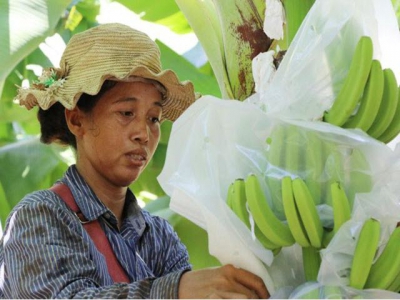China boosts banana growing in Lancang-Mekong region

China plans to help countries in the Lancang-Mekong region tap their banana-growing potential, the Chinese Academy of Tropical Agricultural Sciences said.
A worker wraps bananas at the Green Island Agricultural Development (Cambodia) Ltd. in Kratie province, Cambodia, July 17, 2020. Photo: Xinhua
Academy based in Hainan province aims to help lift people out of poverty
Academy vice-president Xie Jianghui said the banana industry has played a bigger role in recent years in countries along the river, which is known as the Lancang in China and the Mekong outside its borders, and China has begun seeking cooperation in the area and helping to lift local people out of poverty through related businesses.
China is the world's second-biggest producer and consumer of bananas and was estimated to have produced 9.9 million metric tons last year and to have imported 3 million tons from countries including the Philippines and Ecuador, Xie, also chief scientist of the National Banana Industry Technology Systems, said.
Countries in the Lancang-Mekong area such as Cambodia, Laos and Myanmar have advantages in growing bananas such as lower labor costs and better weather conditions, Wang Anbang, head of the cooperation project for the region's banana industry, said.
"Emerging countries like Cambodia still have plentiful farmland without blight and have less pesticide pollution," he said. "Meanwhile, more sunlight and fewer typhoons can shorten the growth cycle, and are more suitable for large-scale and high-quality banana growing."
CATAS, a scientific and research institution under the Ministry of Agricultural and Rural Affairs, is located in South China's Hainan province.
High-standard demonstration planting bases have been built in countries in the Lancang-Mekong area to display new banana varieties and encourage local farmers to join the industry and shake off poverty.
Hainan Dingyi Green Island Ecological Agriculture has built a 6.7-hectare banana demonstration base and a 200-hectare banana plantation in Cambodia.
The company employs more than 250 Cambodian workers in the banana industry and produces 10,000 tons of bananas a year. It plans to expand the planting area to 2,000 hectares by the end of this year.
Heng Sokra, a company employee, said in a video interview with the academy that he plans to buy a piece of land near the base in Kratie province in northeastern Cambodia and build a house there.
He has been working for the company since 2008, and is now a project contractor.
"As a contractor, my salary is not stable, so I work hard to earn more," he said. "I can get an average monthly salary of $800."
His wife works at the company's canteen and their daughter, who grew up in the company's dormitory, now packs bananas at the base.
Many colleagues also started their families at the base, he said.
The company said it has invested $500,000 constructing roads and bridges, and has donated $253,000 to the education and religious sector in the province.
The banana industry that China developed in northern Myanmar has helped farmers in the region switch from growing opium poppies and has contributed to China's anti-drug efforts in the border area, said An Guojun, an official with the Ministry of Public Security's Narcotics Control Bureau.
Shwe Thein was one of a thousand opium poppy growers relocated in 2010 to grow nonnarcotic alternatives at the base of Yunnan Jinxin General Agriculture in Kachin state.
"I earn an annual income of 4,500 yuan ($687) by working on the banana base, much higher than growing opium poppies with a yearly income of 800 yuan," Shwe Thein said in a transcript of an interview released by the academy.
The company said it grows bananas on 6,900 hectares of land in Myanmar and employs more than 10,000 workers from the country. It has also invested 40 million yuan in improving local infrastructure.
By 2019, Chinese companies were growing bananas on 63,300 hectares of land in countries including Myanmar, Laos, Cambodia, Thailand and Vietnam, the academy said, adding they had built an entire industrial chain from variety selection to processing.
Có thể bạn quan tâm
Phần mềm

Phối trộn thức ăn chăn nuôi

Pha dung dịch thủy canh

Định mức cho tôm ăn

Phối trộn phân bón NPK

Xác định tỷ lệ tôm sống

Chuyển đổi đơn vị phân bón

Xác định công suất sục khí

Chuyển đổi đơn vị tôm

Tính diện tích nhà kính

Tính thể tích ao hồ




 Agricultural products increase sharply in both output and…
Agricultural products increase sharply in both output and…  Rice exports drying up but bananas more appealing
Rice exports drying up but bananas more appealing